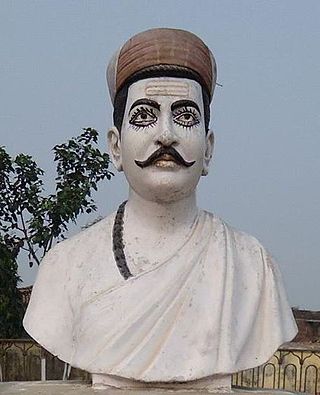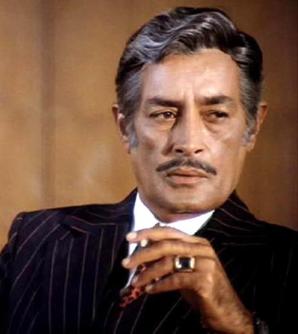
Radha, also called Radhika, is a Hindu goddess and the chief consort of the god Krishna. She is the goddess of love, tenderness, compassion, and devotion. In scriptures, Radha is mentioned as the avatar of Lakshmi and also as the Mūlaprakriti, the Supreme goddess, who is the feminine counterpart and internal potency of Krishna. Radha accompanies Krishna in all his incarnations. Radha's birthday is celebrated every year on the occasion of Radhashtami.

Bihar is a state in eastern India. It is the third largest state by population, the 12th largest by area, and the 14th largest by GDP in 2021. Bihar borders Uttar Pradesh to its west, Nepal to the north, the northern part of West Bengal to the east, and Jharkhand to the south. The Bihar plain is split by the river Ganges, which flows from west to east.

Maithili is an Indo-Aryan language spoken in parts of India and Nepal. It is native to the Mithila region, which encompasses parts of the Indian states of Bihar and Jharkhand as well as the Nepalese Koshi and Madhesh Provinces. It is one of the 22 official languages of India. It is the second most commonly spoken language of Nepal. It is also one of the fourteen provincial official languages of Nepal. It was once described by linguist Sir George Abraham Grierson as the "sweetest language".

Vidyapati, also known by the sobriquet Maithil Kavi Kokil, was a Maithili and Sanskrit polymath-poet-saint, playwright, composer, biographer, philosopher, law-theorist, writer, courtier and royal priest. He was a devotee of Shiva, but also wrote love songs and devotional Vaishnava songs. He knew Sanskrit, Prakrit, Apabhramsha and Maithili.

The history of Bihar is one of the most varied in India.Chirand, on the northern bank of the Ganga River, in Saran district, has an archaeological record dating from the Neolithic age. Regions of Bihar—such as Magadha, Mithila and Anga—are mentioned in religious texts and epics of ancient India. Mithila is believed to be the centre of Indian power in the Later Vedic period. Mithila first gained prominence after the establishment of the ancient Videha Kingdom. The kings of the Videha were called Janakas. A daughter of one of the Janaks of Mithila, Sita, is mentioned as consort of Lord Rama in the Hindu epic Ramayana. The kingdom later became incorporated into the Vajjika League which had its capital in the city of Vaishali, which is also in Mithila.

Radha-Krishna is the combined form of the Hindu god Krishna with his chief consort and shakti Radha. They are regarded as the feminine as well as the masculine realities of God, in several Krishnaite traditions of Vaishnavism.

Binod Bihari Verma (1937–2003) was a Maithili writer and military doctor. He is known for Maithili Karna Kayasthak Panjik Sarvekshan, his work on ancient genealogical charts known as Panjis, as well as his depiction of rural poor of the Mithila region. He worked as a medical officer in the Indian Army, as a lecturer in a Dental College, and as a private medical practitioner. He simultaneously carried on his literary career via independent publishing and in the magazines Mithila Mihir and Karnamrit.

Iftekhar Ahmed Sharif, often mononymously credited as Iftekhar or Iftikhar, was an Indian actor who mainly worked in Hindi cinema. He is known for his film roles as a police officer.

Balanak Bonihar O Pallavi is a short story collection, written by Dr Binod Bihari Verma, on the village life of Mithila on the banks of the Kosi River and its tributaries.

Professor Radha Krishna Choudhary was an Indian historian, thinker, and writer. He contributed to the historical and archaeological studies of Bihar as well as to Maithili literature. He published numerous original researches on the history of Bihar and was acclaimed as a researcher. He was a professor at Ganesh Dutt College, Begusarai, Bihar and was a noted educationist. His languages of choice for academic works were Hindi and English, and for literary work was Maithili.

Gulab Khandelwal was an Indian poet who wrote poetry in different forms such as Lyrics, Sonnets, Rubais (Quatrains), Dohas (Couplets), Odes, Elegies, Lyrical Ballads, Epics, Poetic Dramas, Ghazals, and Masnavi with equal felicity. He even introduced some of these forms into Hindi literature and, apart from Hindi, has also written poetry in Urdu and English. The span of his poetic language touches upon Sanskrit on one end and Urdu on the other. Gulab Khandelwal died in Ohio on 2 July 2017.
Bihari culture refers to the culture of the Indian state of Bihar. Bihari culture includes Angika culture, Mithila culture, Bhojpuri Culture and the culture of Magadha.
Brajabuli is an artificial literary language popularized by the Maithili poet Vidyapati. His Brajabuli lyrics about the love which were turned out to be for Radha Krishna later on these are considered his best work. Other poets emulated his writing, and the language became established in the 16th century. Among the medieval Bengali poets who wrote in Brajabuli are Narottama Dasa, Balarama Das, Jnanadas, and Gobindadas Kabiraj.
Maithili literature is the entire collection of poetry, novels, short stories, documents and other writings in the Maithili language. The most famous literary figure in Maithili is the poet Vidyapati (1350–1450), who wrote his poems in the language of the people, i.e., Maithili, at a time when state's official language was Sanskrit and Sanskrit was being used as a literary language. The use of Maithili, instead of Sanskrit, in literature became more common after Vidyapati.
Surendra Jha 'Suman', also referred to as 'Suman Ji' or Acharya Surendra Jha 'Suman', was a Maithili poet, writer, publisher, editor and elected member of legislative assembly and parliament. He is also known for his role as publisher, editor, journalist, social and cultural reformer and promoter of Mithila culture. He authored about forty books in Maithili and was also the Editor of various publications and books in Maithili, Sanskrit and Hindi. He served the Governing Bodies of various literary and academic institutions in different capacities in his State. He was also the recipient of Sahitya Akademy Award in 1971 for Payaswini and in 1995 for Translation Rabindra Natakavali Vol. I. He was born in a village known as Ballipur in the Samastipur district of Bihar.

Mithila State Movement is a movement advocating a separate Mithila state in India. This movement gained momentum in 1902 AD when Sir George Grierson, an official of the British Indian government, prepared a map of Mithila state by conducting a language-based survey. In 1881 AD, the word Mithila was added to the dictionary of the British India government. According to the founder, president Dr. Dhanakar Thakur of the International Maithili Council in the proposed Mithila state, 24 districts of Bihar and six districts of Jharkhand, a total of 30 districts, have been included, which has a population of about 70 million. At the same time, the area is 70 thousand square km.










